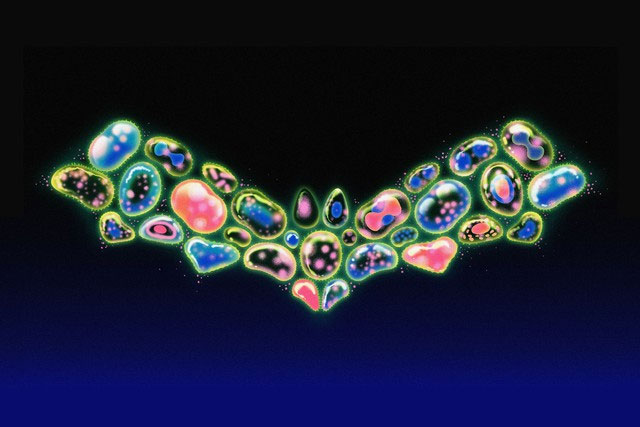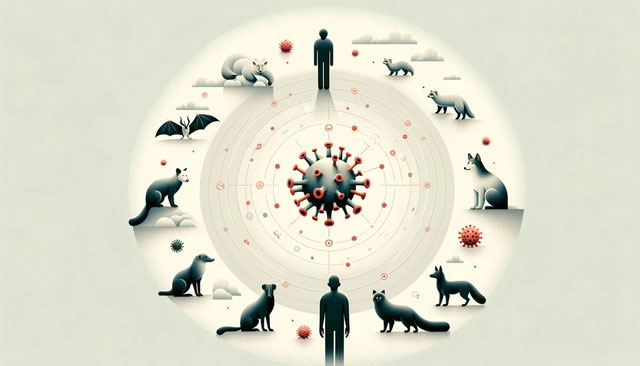Humans transmit twice as many viruses to animals as we transmit from them!
These findings challenge our understanding of zoonotic diseases and highlight our indispensable role in the ecosystem's exchange of viruses.
The COVID pandemic has brought the spread of zoonotic diseases into the spotlight. The leading theory is that SARS-CoV-2, the virus that causes Covid-19, mutated in bats and then spread to other wild animals sold alive for food. and they eventually infect humans.
This is not surprising because we have had to deal with many zoonotic diseases in the past, from Ebola to bird flu and swine flu . But in reality the transmission process is always a two-way street.

Researchers at University College London (UCL) have now investigated the virus's behavior in unprecedented detail, revealing a startling truth: humans transmit just as many viruses to wild animals and This amount is twice as much as the amount we infect from them.
Professor Francois Balloux of UCL and co-author of the new study said: "Human transmission of diseases from humans to animals is much more common than we thought. Humans act as the origin of these viruses rather than a transition site in the flow of viral exchange between host species".

The path of viral infection is two-way
Anthroponosis , or the spread of viruses from humans to other animals, is increasingly being detected. Typical examples are the 2009 influenza A (H1N1) epidemic in pigs and the SARS-CoV-2 epidemic in mink and white-tailed deer. Pet owners may be more aware of this dynamic as dogs, cats and even ferrets, often exhibit flu-like symptoms after close contact with an infected person.
The importance of the virus source coming from humans has not yet had many detailed studies. For their study, the researchers set the enormous task of analyzing nearly 12 million viral genomes. They are used to build phylogenetic trees to help researchers find patterns in previous host jumps.
Imagine a situation in which viruses are found in both bats and humans, and virus strains from these two hosts differ by only a few mutations. This similarity suggests a recent transmission event. But the important question is: who infects whom? That is the purpose of a phylogenetic tree.

Virus family tree
These phylogenetic trees are essentially family trees of viruses. By mapping out the evolutionary relationships between different virus strains, one can find their common ancestors. Such trees also allow scientists to infer the direction of the virus host's jump.
This is not a trivial task, because the volume of data itself is huge, in addition the ecological diversity of viruses is much richer than previously classified using conventional methods. To overcome this problem, the researchers constructed their own phylogenetic tree consisting of 32 virus families based solely on genetic relationships.

'In fact, 45% of sequences were missing host information and 37% were missing sampling date. Additionally, we tend to focus on viruses that infect humans, with 93% of all viral sequences associated with humans. This large sampling bias poses a major challenge to existing analytical methods, and we spent a lot of time ensuring that our results were not an artifact of it' , Cedric Tan , PhD student at UCL's Institute of Genetics and the Francis Crick Institute, and lead author of the study, told ZME Science .
The researchers created a detailed classification of viruses by grouping related viral sequences and their hosts. They tracked the evolution of each group to understand how viruses jump between hosts and evolve over time. This work reveals a global network of viruses that infect vertebrates, providing a new tool to track the spread of disease.
Humans are the main actors

By meticulously reconstructing the evolutionary history of the virus and examining genetic mutations acquired during host infection, researchers have completely reversed the notion of humans as just the endpoint. of viral diseases. Their most intriguing revelation is that cases of human-to-animal transmission are nearly twice as common as the reverse.
This once again emphasizes the fact that humans are never outside of nature - although our arrogance may make us think otherwise. Instead, we are an integral part of a complex ecosystem, constantly exchanging pathogens with other species.
The study also explored the genetic underpinnings of these host jumps. They found that viruses often undergo significant mutations as they adapt to new hosts. Interestingly, viruses with many animal hosts show fewer signs of such adaptive mutations.
'Another interesting result is that viruses with a wide host range require fewer evolutionary changes to adapt to new hosts. This may explain the common pattern that the viruses of most interest as possible agents of epidemics and pandemics tend to be able to infect multiple hosts ,' Balloux said.
- How did viruses from animals to humans evolve?
- How does a virus jump from animal to human?
- Animals carry at least 320,000 dangerous virus species
- Detected 18 viruses in wild animals that pose a risk to humans
- Discovering new viruses that harm animals
- Are animals raised by humans smarter than wild animals?
- Marine animals protect the Earth from millions of viruses
- Science explains the difference between humans and animals
- What if all the animals on Earth turned against humans?
- Warning of dangerous viruses transmitted from monkeys to humans
- Discovered 3 new corona viruses in bats that can be harmful to humans
- Detection of new dangerous influenza viruses
 Why do potatoes have eyes?
Why do potatoes have eyes? 'Tragedy' the world's largest carnivorous life: Death becomes ... public toilet
'Tragedy' the world's largest carnivorous life: Death becomes ... public toilet Tomatoes were once considered 'poisonous' for 200 years
Tomatoes were once considered 'poisonous' for 200 years Detecting microscopic parasites on human face
Detecting microscopic parasites on human face